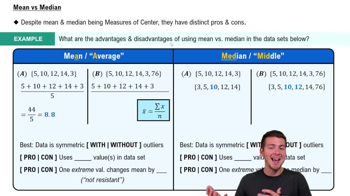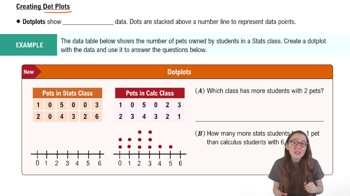Body Temperatures Listed below are the temperatures from nine males measured at 8 AM and again at 12 AM (from Data Set 5 “Body Temperatures” in Appendix B). Construct a scatterplot. Based on the graph, does there appear to be a relationship between 8 AM temperatures and 12 AM temperatures?
Table of contents
- 1. Intro to Stats and Collecting Data1h 14m
- 2. Describing Data with Tables and Graphs1h 55m
- 3. Describing Data Numerically2h 5m
- 4. Probability2h 16m
- 5. Binomial Distribution & Discrete Random Variables3h 6m
- 6. Normal Distribution and Continuous Random Variables2h 11m
- 7. Sampling Distributions & Confidence Intervals: Mean3h 23m
- Sampling Distribution of the Sample Mean and Central Limit Theorem19m
- Distribution of Sample Mean - Excel23m
- Introduction to Confidence Intervals15m
- Confidence Intervals for Population Mean1h 18m
- Determining the Minimum Sample Size Required12m
- Finding Probabilities and T Critical Values - Excel28m
- Confidence Intervals for Population Means - Excel25m
- 8. Sampling Distributions & Confidence Intervals: Proportion1h 12m
- 9. Hypothesis Testing for One Sample3h 29m
- 10. Hypothesis Testing for Two Samples4h 50m
- Two Proportions1h 13m
- Two Proportions Hypothesis Test - Excel28m
- Two Means - Unknown, Unequal Variance1h 3m
- Two Means - Unknown Variances Hypothesis Test - Excel12m
- Two Means - Unknown, Equal Variance15m
- Two Means - Unknown, Equal Variances Hypothesis Test - Excel9m
- Two Means - Known Variance12m
- Two Means - Sigma Known Hypothesis Test - Excel21m
- Two Means - Matched Pairs (Dependent Samples)42m
- Matched Pairs Hypothesis Test - Excel12m
- 11. Correlation1h 6m
- 12. Regression1h 50m
- 13. Chi-Square Tests & Goodness of Fit1h 57m
- 14. ANOVA1h 57m
2. Describing Data with Tables and Graphs
Visualizing Qualitative vs. Quantitative Data
Problem 3.CQQ.5
Textbook Question
Roller Coaster Speed Outlier Identify any outliers among the data listed for Exercise 1.
 Verified step by step guidance
Verified step by step guidance1
Step 1: Understand the concept of outliers. Outliers are data points that are significantly different from the rest of the dataset. They can be identified using statistical methods such as the Interquartile Range (IQR) or Z-scores.
Step 2: Organize the data in ascending order. This helps in calculating measures like the median and quartiles, which are essential for identifying outliers using the IQR method.
Step 3: Calculate the first quartile (Q1) and third quartile (Q3). Q1 is the median of the lower half of the data, and Q3 is the median of the upper half of the data.
Step 4: Compute the Interquartile Range (IQR) using the formula: . Then, determine the lower and upper bounds for outliers using the formulas: and .
Step 5: Compare each data point to the lower and upper bounds. Any data point that falls below the lower bound or above the upper bound is considered an outlier.
 Verified video answer for a similar problem:
Verified video answer for a similar problem:This video solution was recommended by our tutors as helpful for the problem above
Video duration:
4mPlay a video:
Was this helpful?
Key Concepts
Here are the essential concepts you must grasp in order to answer the question correctly.
Outliers
Outliers are data points that differ significantly from other observations in a dataset. They can indicate variability in measurement, experimental errors, or novel phenomena. Identifying outliers is crucial as they can skew statistical analyses and affect the results of tests, leading to potentially misleading conclusions.
Recommended video:
Guided course

Comparing Mean vs. Median
Statistical Measures
Statistical measures such as mean, median, and standard deviation are essential for understanding the distribution of data. The mean provides the average value, while the median offers the middle point, and the standard deviation indicates the spread of data around the mean. These measures help in determining whether a data point is an outlier by comparing it to the overall dataset.
Recommended video:
Guided course

Parameters vs. Statistics
Box Plot
A box plot is a graphical representation that summarizes the distribution of a dataset through its quartiles. It highlights the median, upper and lower quartiles, and potential outliers. By visualizing the data in this way, one can easily identify outliers that fall outside the whiskers of the box plot, facilitating a clearer understanding of data variability.
Recommended video:

Creating Dotplots

 4:39m
4:39mWatch next
Master Visualizing Qualitative vs. Quantitative Data with a bite sized video explanation from Patrick
Start learningRelated Videos
Related Practice
Textbook Question
